The red, white and blue balloons bobbed outside Old City’s gallery doors, but the brouhaha celebrating the opening of the Constitution Center didn’t seem to touch Old City, which was unusually quiet.
Helllooo. If you move First Friday to a Wednesday, not too many people are going to come.
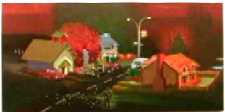
But the art showed up, and some of it looked wild and juicy. Like the creepy, overheated suburbs (“Street Corner” shown) in Roland Becerra’s oils at Roger LaPelle, 122 N. Third Street. The figures look like action figures, the scenarios like horror movie or action movie stills, and the Virgin Mary shrine looks even less natural–but way more alive–than the real thing. Guys carry submachine guns. Insects light the path of approaching figures. And lit-up Victorian doll houses provide the stage for “Psycho” or “Godzilla.” These suburbs are way far from heaven.
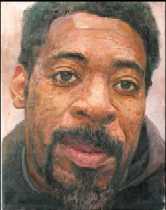 While Becerra has used his high-art academy technique for pop culture topics, former Fleisher Challenge exhibitor Qimin Liu at Artists House uses his high-art academy technique to create portraits of society’s dispossessed. These are not the usual portraits of white-skinned burghers, their possessions telegraphing who they are and what they value. They are faces stripped bare of props, the rich background interiors of traditional portraiture reduced to nothing but sky, a mark of the subjects’ homeless days and nights spent under the sun and stars (“Under the Sky #4” shown). Liu makes visible the faces middle-class whites avoid studying, and that’s his personal revolution.
While Becerra has used his high-art academy technique for pop culture topics, former Fleisher Challenge exhibitor Qimin Liu at Artists House uses his high-art academy technique to create portraits of society’s dispossessed. These are not the usual portraits of white-skinned burghers, their possessions telegraphing who they are and what they value. They are faces stripped bare of props, the rich background interiors of traditional portraiture reduced to nothing but sky, a mark of the subjects’ homeless days and nights spent under the sun and stars (“Under the Sky #4” shown). Liu makes visible the faces middle-class whites avoid studying, and that’s his personal revolution.
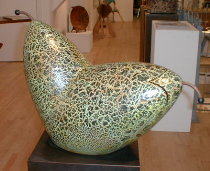 Wendell Castle’s sexy “Crux,” (shown–pull on the right stem and a drawer pulls out) made of polychromed julutong, bronze and brass, was one of a number of excellent pieces at Snyderman tied in with last month’s furniture extravaganza. Other items of note include Jon Brooks’ chairs and John Eric Byers’ milk-painted furniture, including a dizzying geometric pattern covering a piano and two stools.
Wendell Castle’s sexy “Crux,” (shown–pull on the right stem and a drawer pulls out) made of polychromed julutong, bronze and brass, was one of a number of excellent pieces at Snyderman tied in with last month’s furniture extravaganza. Other items of note include Jon Brooks’ chairs and John Eric Byers’ milk-painted furniture, including a dizzying geometric pattern covering a piano and two stools.
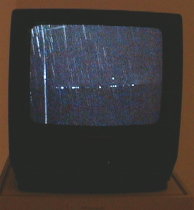 In sharp contrast, Larry Becker’s summer group show of minimalist work offers a visual break accompanied by intellectual challenge. Kocot and Hatton’s infrared “Rain” (shown) is a videotape of rain falling (in Ocean City). The piece is a companion to the work the couple have down at the Delaware Center for Contemporary Art. And David Goerk’s small chunks of wood [“Oblique Block (B & W)” shown, is 4” by 4” by 2”] provide what-is-its for the wall and mind.
In sharp contrast, Larry Becker’s summer group show of minimalist work offers a visual break accompanied by intellectual challenge. Kocot and Hatton’s infrared “Rain” (shown) is a videotape of rain falling (in Ocean City). The piece is a companion to the work the couple have down at the Delaware Center for Contemporary Art. And David Goerk’s small chunks of wood [“Oblique Block (B & W)” shown, is 4” by 4” by 2”] provide what-is-its for the wall and mind. 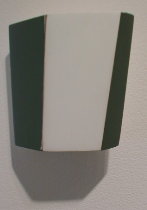 I also enjoyed Marcia Hafif’s work, the latter a pulsing yellow-orange colorfield called “Glaze Painting: Naples Yellow/Indian Yellow.” As hot, hot, hot as spareness can go.
I also enjoyed Marcia Hafif’s work, the latter a pulsing yellow-orange colorfield called “Glaze Painting: Naples Yellow/Indian Yellow.” As hot, hot, hot as spareness can go.
On departing Becker, we spotted non-minimalist artist Sydney Goodman entering, thereby making the gallery a meeting ground for minimalism and representation.
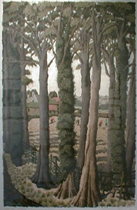 Pringle’s summer group show, which included mostly international artists, had a nice piece by English watercolorist Simon Palmer (“Clutching at Straws” shown), whose sinewed trees overwhelm the field of tiny gleaners in the background. Iceland native Karolina Larusdottir, who is an illustrator of children’s books with a strong commercial track record, offered etchings with ambiguous narrative scenes. My two favorites–”The Crossing” and “Free Ride”–were set by the ocean, the people in black and white, the background in color. I wondered if there was some political content here.
Pringle’s summer group show, which included mostly international artists, had a nice piece by English watercolorist Simon Palmer (“Clutching at Straws” shown), whose sinewed trees overwhelm the field of tiny gleaners in the background. Iceland native Karolina Larusdottir, who is an illustrator of children’s books with a strong commercial track record, offered etchings with ambiguous narrative scenes. My two favorites–”The Crossing” and “Free Ride”–were set by the ocean, the people in black and white, the background in color. I wondered if there was some political content here.
 At Highwire’s group show, the notables were two guys with lots of drips. Theodore Mosher offered ink-blot covered drawings and small drippy paintings, some with art-historical references, and Bob Gorchov had an existential, smudgy touch (shown, “Animal Skeleton/4) with people and skeletons.
At Highwire’s group show, the notables were two guys with lots of drips. Theodore Mosher offered ink-blot covered drawings and small drippy paintings, some with art-historical references, and Bob Gorchov had an existential, smudgy touch (shown, “Animal Skeleton/4) with people and skeletons.
The standout print at the Cheltenham Printmaker’s Guild show at Muse Gallery was Herbert Appelson’s City Skyline,” stitched and embossed and surprising. “
“









